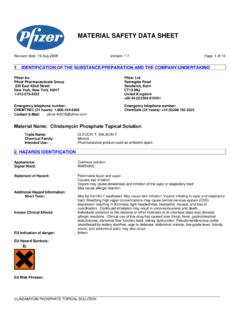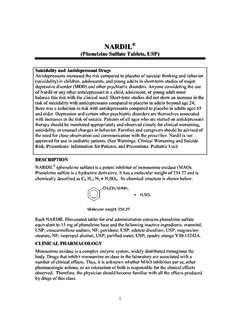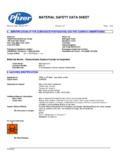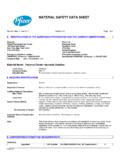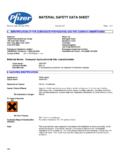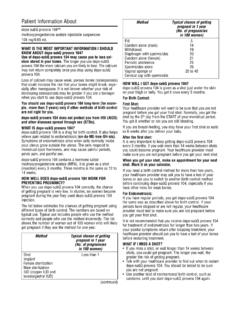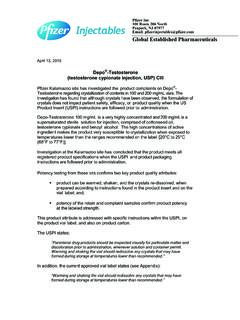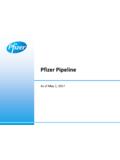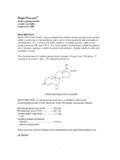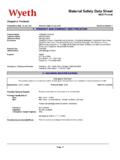Transcription of MATERIAL SAFETY DATA SHEET - Pfizer
1 MATERIAL SAFETY data SHEET . Revision date: 15-Jan-2013 Version: Page 1 of 7. 1. identification OF THE SUBSTANCE/PREPARATION AND THE COMPANY/UNDERTAKING. Pfizer Inc Pfizer Ltd Pfizer Pharmaceuticals Group Ramsgate Road 235 East 42nd Street Sandwich, Kent New York, New York 10017 CT13 9NJ. 1-212-573-2222 United Kingdom +00 44 (0)1304 616161. Emergency telephone number: Emergency telephone number: CHEMTREC (24 hours): 1-800-424-9300 International CHEMTREC (24 hours): +1-703-527-3887. Contact E-Mail: MATERIAL Name: Penicillin G potassium for injection Trade Name: PFIZERPEN. Chemical Family: Penicillin Intended Use: Pharmaceutical product used as antibiotic agent 2.
2 hazards identification . Appearance: White crystalline powder Signal Word: DANGER. Statement of Hazard: May cause allergic or asthmatic symptoms or breathing difficulties if inhaled. May cause allergic skin reaction. Additional Hazard Information: Short Term: Individuals who are allergic to penicillin antibiotics could have allergic reaction, possibly severe. If an allergic reaction occurs, the worker should be removed to the nearest emergency room and the appropriate therapy instituted. Known Clinical Effects: May cause effects similar to those seen in clinical use including transient diarrhea, nausea and abdominal pain.
3 Individuals who are sensitive to beta lactam antibiotics, both penicillins and cephalosporins, may experience contact or systemic hypersensitivity and anaphylaxis upon exposure to this drug. EU Indication of danger: Harmful EU Hazard Symbols: EU Risk Phrases: R42/43 - May cause sensitization by inhalation and skin contact. Australian Hazard Classification Hazardous Substance. Non-Dangerous Goods. (NOHSC): _____. 150. MATERIAL SAFETY data SHEET . MATERIAL Name: Penicillin G potassium for injection Page 2 of 7. Revision date: 15-Jan-2013 Version: _____. 2. hazards identification . Note: This document has been prepared in accordance with standards for workplace SAFETY , which require the inclusion of all known hazards of the active substance or its intermediates regardless of the potential risk.
4 The precautionary statements and warnings included may not apply in all cases. Your needs may vary depending upon the potential for exposure in your workplace. 3. COMPOSITION/INFORMATION ON INGREDIENTS. Hazardous Ingredient CAS Number EU EINECS/ELINCS List EU Classification %. Penicillin G potassium 113-98-4 204-038-0 Xn;R42/43 *. Citric acid 77-92-9 201-069-1 Xi; R36 **. Ingredient CAS Number EU EINECS/ELINCS List EU Classification %. Sodium citrate 68-04-2 200-675-3 Not Listed **. Additional Information: ** to adjust pH. Ingredient(s) indicated as hazardous have been assessed under standards for workplace SAFETY .
5 For the full text of the R phrases mentioned in this Section, see Section 16. 4. FIRST AID MEASURES. Eye Contact: Immediately flush eyes with water for at least 15 minutes. If irritation occurs or persists, get medical attention. Skin Contact: Remove contaminated clothing. Flush area with large amounts of water. Use soap. Seek medical attention. For information on potential delayed effects, see Section 2 - hazards identification and/or Section 11 - Toxicological Information. Ingestion: Never give anything by mouth to an unconscious person. Wash out mouth with water. Do not induce vomiting unless directed by medical personnel.
6 Seek medical attention immediately. Inhalation: Remove to fresh air and keep patient at rest. Seek medical attention immediately. Symptoms and Effects of Exposure: For information on potential signs and symptoms of exposure, See Section 2 - hazards identification and/or Section 11 - Toxicological Information. 5. FIRE FIGHTING MEASURES. Extinguishing Media: Use carbon dioxide, dry chemical, or water spray. Hazardous Combustion Products: Emits toxic fumes of carbon monoxide, carbon dioxide, nitrogen oxides, sulfur oxides and other sulfur-containing compounds. Fire Fighting Procedures: Wear approved positive pressure, self-contained breathing apparatus and full protective turn out gear.
7 Evacuate area and fight fire from a safe distance. Fire / Explosion hazards : Fine particles (such as dust and mists) may fuel fires/explosions. _____. 150. MATERIAL SAFETY data SHEET . MATERIAL Name: Penicillin G potassium for injection Page 3 of 7. Revision date: 15-Jan-2013 Version: _____. 6. ACCIDENTAL RELEASE MEASURES. Health and SAFETY Precautions: Personnel involved in clean-up should wear appropriate personal protective equipment (see Section 8). Minimize exposure. Measures for Cleaning / Collecting: Contain the source of spill if it is safe to do so. Collect spilled MATERIAL by a method that controls dust generation.
8 A damp cloth or a filtered vacuum should be used to clean spills of dry solids. Clean spill area thoroughly. Measures for Environmental Place waste in an appropriately labeled, sealed container for disposal. Care should be taken to Protections: avoid environmental release. Additional Consideration for Large Non-essential personnel should be evacuated from affected area. Report emergency Spills: situations immediately. Clean up operations should only be undertaken by trained personnel. 7. HANDLING AND STORAGE. General Handling: Minimize dust generation and accumulation. Avoid inhalation and contact with skin, eye, and clothing.
9 When handling, use appropriate personal protective equipment (see Section 8). Wash hands and any exposed skin after removal of PPE. Releases to the environment should be avoided. Review and implement appropriate technical and procedural waste water and waste disposal measures to prevent occupational exposure or environmental releases. Potential points of process emissions of this MATERIAL to the atmosphere should be controlled with dust collectors, HEPA filtration systems or other equivalent controls. Storage Conditions: Store as directed by product packaging. 8. EXPOSURE CONTROLS / PERSONAL PROTECTION. The purpose of the Occupational Exposure Band (OEB) classification system is to separate substances into different Hazard categories when the available data are sufficient to do so, but inadequate to establish an Occupational Exposure Limit (OEL).
10 The OEB given is based upon an analysis of all currently available data ; as such, this value may be subject to revision when new information becomes available. Penicillin G potassium Pfizer Occupational Exposure OEB 2 - Sensitizer (control exposure to the range of 100ug/m3 to < 1000ug/m3, provide Band (OEB): additional precautions to protect from skin contact). Analytical Method: Analytical method available for Penicillin G Potassium. Contact Pfizer Inc for further information. Engineering Controls: Engineering controls should be used as the primary means to control exposures. General room ventilation is adequate unless the process generates dust, mist or fumes.
